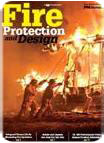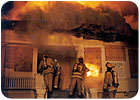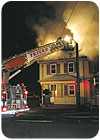
Sixty-one years ago, at the 1947 President’s Conference on Fire Prevention, President Harry S. Truman told those in attendance, “the serious losses in life and property resulting annually from fires cause me deep concern. I am sure that such unnecessary waste can be reduced. The substantial progress made in the science of fire prevention and fire protection in this country during the past 40 years convinces me that the means are available for limiting this unnecessary destruction.”
The reason for direct involvement from the highest level of government six decades ago was a series of tragic fire losses that plagued the country: the 1942 fire at the Coconut Grove in Boston (492 dead); the 1943 Gulf Motel Fire in Houston (54 dead); the 1944 Ringling Brothers and Barnum & Bailey circus fire in Hartford (167 dead); the 1946 LaSalle Hotel fire in Chicago (61 dead); and the 1946 Winecoff Hotel fire in Atlanta (119 dead).
The Proceedings of the 1947 President’s Conference on Fire Prevention indicates that Walter A. Taylor, director of the Department of Education and Research of the American Institute of Architects (AIA), also spoke at the conference and agreed with President Truman’s assessment. He stated:
“Since the inception of this campaign, our organization has urged the broadest scope and interpretation and an emphasis upon safety for human life as the ultimate criterion of codes and actions. Everyone is of course concerned, at least indirectly, about human casualties and loss of life due to fires. However, it would seem that many codes and proposed standards have been framed primarily to preserve buildings and their contents, rather than human lives. The architect shares fully the concern of the owners, the technicians and economists over the stupendous financial losses due to fires. But the architect, among the technicians and design professions in his approach to any problem, usually gives greater weight to the direct effect upon human beings…
This is obvious, and it is therefore also obvious that the importance and potential success of this campaign lies in the participation of many large and influential groups outside the architectural and engineering professions, whose interests are solely humanitarian and civic. Government agencies which are guiding and setting standards for various types of buildings can do a great deal to improve fire safety by strengthening and emphasizing their requirements.
The officers, directors, and staff of the American Institute of Architects pledge their best efforts to the continuing support of the President’s campaign. Individual architects, as citizens and in their professional practice, may be relied upon to use their skill and persuasion in the interest of fire safety; but in many large and important public and semipublic buildings we shall be powerless unless by united effort of all who are here represented, public opinion is aroused to a demand for clarification, enactment, and enforcement of codes which are ready and available in the form of standards and recommendations, awaiting your moral support and legal implementation.”

Photo credit: www.lwfd.org
Ultimate Criterion of Codes and Actions
The reason for focusing extensively on the AIA’s position from 61 years ago is to establish that, historically, AIA clearly believed in “safety for human life as the ultimate criterion of codes and actions.” And to achieve that end, AIA strongly supported and depended on the idea that “government agencies which are guiding and setting standards for various types of buildings can do a great deal to improve fire safety by strengthening and emphasizing their requirements.”These statements were not only the accurate depiction of the fire problems back in 1947, they are still quite applicable to the fire and life safety challenges in our country today. Not only did they clearly identify that life safety is the most important design criterion, but they also promoted unity of purpose and cooperation between the public safety officials and the design professionals to work hand in hand in striving for a safer community. Most importantly, they clearly underlined the significance of the codes, and the instrumental role of the code development agencies in strengthening their codes and setting higher standards for fire and life safety.
Today, however, some in the architectural industry could be considered as opposing measures to strengthen fire and life safety codes that are designed to protect human life and property. This perceived stance can be attributed to rising construction costs and the architects’ strong belief in maintaining artistic creativity and design freedom. A quick look at some of the current code change proposals supports this claim. The most notable is their opposition to the National Institute of Standards and Technology (NIST) recommendations related to the World Trade Center. And there are also other proposals in different types of occupancies that are meeting similar levels of resistance.
In their Aug. 21, 2006, justification letter to the International Code Council (ICC) titled, “Examination of Fire Deaths-Building Occupancy and Type,” AIA stated: “The point is that the number of fire service personnel killed in a fire is less than the number of citizens killed in fires by a factor of about three or more. However, even looking at the total number of firefighter deaths, it is barely more than two deaths per state each year. Obviously, we do not have numerous deaths in fires anywhere in the U.S…
I hope that gives you a clear picture of the issue that we are facing and the lack of any connection between the height and area of a building. There is no correlation between even a single class of buildings except for single-family residences. The data shows that these changes will cost literally billions in wasted construction with no discernable difference in life safety.”
And then a few pages further in the concluding sentence to their paper titled, “Examination of Loss Records by Building Occupancy and Type,” the AIA states: “We do not have a fire problem in the U.S.-except in single-family dwellings.” I do agree wholeheartedly with the AIA that the crux of the fire problem in America is indeed the single-family homes. But even though the fire loss statistics referenced by AIA are indeed accurate, I am not particularly enthused about their cavalier approach in analyzing them, and even less by the view that characterizes firefighter losses as acceptable or expected collateral losses.
Their views about firefighter fatalities are vastly different than ours in the fire service. But the intent of this article is not to respond back with emotions, but to prove our stance based on logic. My intent is to have the AIA join us in our fight to address the fire problem in America, and by doing so, to not only reduce the civilian fire fatalities but also our firefighter fatalities. I believe that is our professional obligation just as it is theirs. The National Fallen Firefighters Foundation offers 16 Firefighter Life Safety Initiatives, and item 15 states: “Advocacy must be strengthened for the enforcement of codes and installation of home fire sprinklers.”

Photo credit: www.santamonicafire.org
Seeking Support
I believe that for us to succeed, we need the support of the AIA and all other design professionals. Even though the architects might take offense to this article, my intent is not to drive a wedge between us, but to bring us closer together to work on addressing the fire problem in our country. But then that doesn’t mean that we have to close our eyes on our differences, either. It is only healthy to discuss our different perspectives, so that at the end, we can meld our core values and renew our commitments in striving for a safer America.Based on their current statements, it seems that the AIA and the rest of the design professionals participating in the ICC code development process are well aware of the NFPA’s fire loss statistics. They conveniently use those loss statistics to oppose any of our code proposals, be it the NIST WTC recommendations or the Height & Area tables.
They do so, claiming that our proposed changes are too costly, and that the NFPA fire loss statistics do not justify such expenditures, because the majority of the fire losses are in the single-family dwellings. But then, AIA and most of the other design professionals are quite silent on the residential fire sprinkler requirements for the same single-family dwellings that they correctly claim to be the crux of the fire problem in our country.
It appears that, simply, when it is beneficial to them, they use the NFPA fire loss statistics to support their claim in opposing our building code proposals. But then they conveniently remain silent when it comes to residential fire sprinkler requirements for all new one- and two-family dwellings. Why? Maybe because the single-family dwelling market is not what they are involved with or interested in for their design services. It seems that since there is no financial gain, they’d rather remain silent and prefer not to “rock the boat.” It is one thing to not be aware of the truth, but what would you call knowing the truth and yet remaining silent?
The AIA and the design professionals seem to have an in-depth knowledge of the fire loss statistics in our country and know exactly where those losses occur. We should remind them of their current double standards in application of their logic, and that it is their professional obligation to take meaningful stances and tangible measures in seeking a solution to reduce those fire loss statistics that they are so intimately familiar with. And I believe that their support for the residential fire sprinkler requirement in the residential building code could just be that meaningful stance and tangible measure.
It should be quite obvious when comparing the AIA’s current statements with their stance back in 1947 that they have clearly shifted their position. Now, they seem to be more focused on “cost” as a higher design criterion. And in the national code development arenas, they oppose fire and life safety code proposals from the public safety officials merely based on “cost” impacts.
But I believe that the public safety officials are not naïve and inconsiderate to the “cost” issues, and we do recognize the views presented by the architects and other design professionals. I believe that we could, and should, reach cost-effective solutions to provide for our community’s desired level of fire and life safety. But for the architects to disregard the fire and life safety concerns simply for the sake of cost is definitely inappropriate.

Point of Diminishing Return: Reached Yet?
It is important to remember that for the many centuries past-and certainly six decades ago at the time of the 1947 President’s Conference on Fire Prevention-architects and the other design professionals always practiced their design freedom and their cost-effective designs. But back then we did not have strong construction codes; thus we were rather weak in our enforcement.Historically, codes have been strengthened based on the past failures, and many lives were lost to get us up to the levels of safety that we have today. Although avoiding failures might not be truly and completely possible, prudence dictates taking appropriate measures through strengthening the fire and life safety requirements in our codes to reduce such adverse impacts.
Application of the law of diminishing return would indicate that with the investment of capital, reduction in risks and death rates would occur. But then, after a certain point, continued investment would not result in any further reduction of risk and death rates. In reality, that exact point, the point of diminishing return, is the delicate balance between artistic creativity and safety features-between “cost” and “safety.” As public safety officials and design professionals alike, we must recognize and continually evaluate that balance, and through our continued participation in the national code development process, require our code development agencies to set those high standards in their construction codes.
As public safety officials, we are concerned about “cost” as a very important factor in the economic vitality and development of our communities. But on the other hand, architects and the design professionals must fully embrace “fire and life safety” as their most important design criterion, just as was indicated 61 years ago. It is time that all of us-public safety officials, design professionals and the code development agencies-focus more on our common core values and our professional obligation to fulfill the commitment so eloquently outlined by the AIA back in 1947: “safety for human life as the ultimate criterion of codes and actions.”


